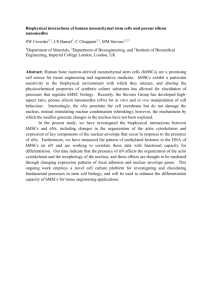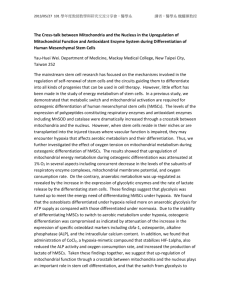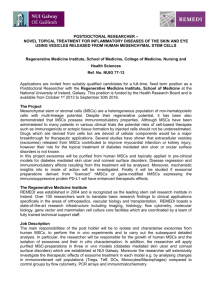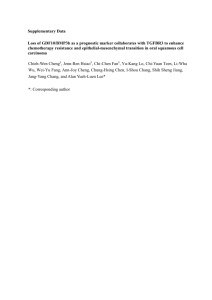BMS-SpecimenFV
advertisement
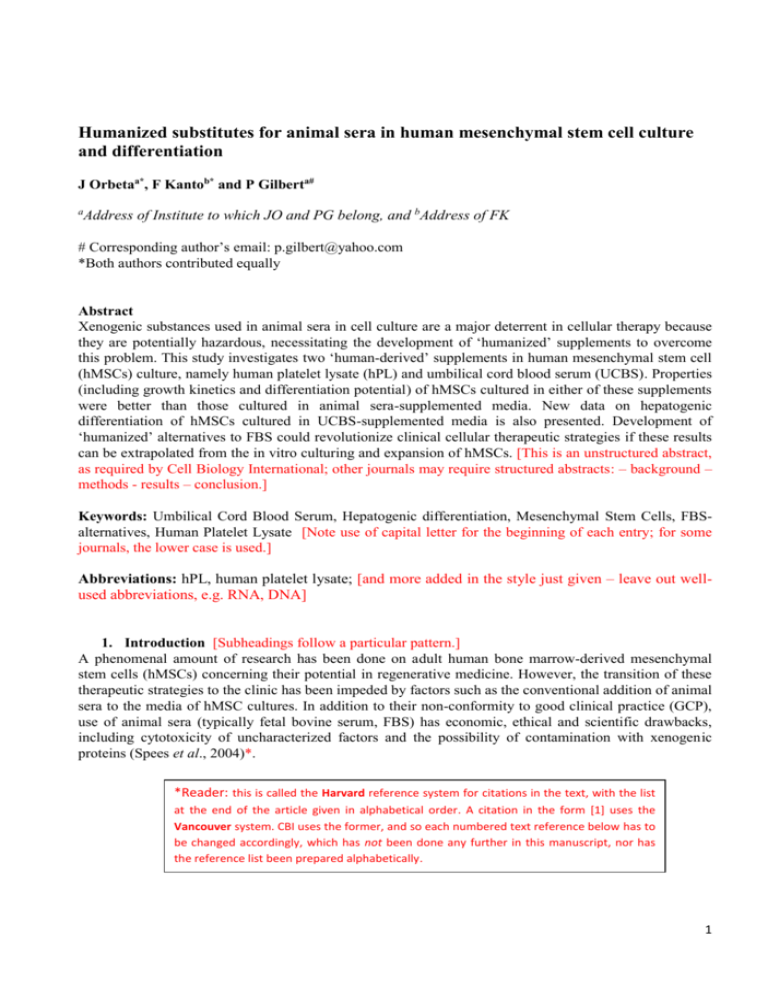
Humanized substitutes for animal sera in human mesenchymal stem cell culture and differentiation J Orbetaa*, F Kantob* and P Gilberta# a Address of Institute to which JO and PG belong, and bAddress of FK # Corresponding author’s email: p.gilbert@yahoo.com *Both authors contributed equally Abstract Xenogenic substances used in animal sera in cell culture are a major deterrent in cellular therapy because they are potentially hazardous, necessitating the development of ‘humanized’ supplements to overcome this problem. This study investigates two ‘human-derived’ supplements in human mesenchymal stem cell (hMSCs) culture, namely human platelet lysate (hPL) and umbilical cord blood serum (UCBS). Properties (including growth kinetics and differentiation potential) of hMSCs cultured in either of these supplements were better than those cultured in animal sera-supplemented media. New data on hepatogenic differentiation of hMSCs cultured in UCBS-supplemented media is also presented. Development of ‘humanized’ alternatives to FBS could revolutionize clinical cellular therapeutic strategies if these results can be extrapolated from the in vitro culturing and expansion of hMSCs. [This is an unstructured abstract, as required by Cell Biology International; other journals may require structured abstracts: – background – methods - results – conclusion.] Keywords: Umbilical Cord Blood Serum, Hepatogenic differentiation, Mesenchymal Stem Cells, FBSalternatives, Human Platelet Lysate [Note use of capital letter for the beginning of each entry; for some journals, the lower case is used.] Abbreviations: hPL, human platelet lysate; [and more added in the style just given – leave out wellused abbreviations, e.g. RNA, DNA] 1. Introduction [Subheadings follow a particular pattern.] A phenomenal amount of research has been done on adult human bone marrow-derived mesenchymal stem cells (hMSCs) concerning their potential in regenerative medicine. However, the transition of these therapeutic strategies to the clinic has been impeded by factors such as the conventional addition of animal sera to the media of hMSC cultures. In addition to their non-conformity to good clinical practice (GCP), use of animal sera (typically fetal bovine serum, FBS) has economic, ethical and scientific drawbacks, including cytotoxicity of uncharacterized factors and the possibility of contamination with xenogenic proteins (Spees et al., 2004)*. *Reader: this is called the Harvard reference system for citations in the text, with the list at the end of the article given in alphabetical order. A citation in the form [1] uses the Vancouver system. CBI uses the former, and so each numbered text reference below has to be changed accordingly, which has not been done any further in this manuscript, nor has the reference list been prepared alphabetically. 1 These matters raise the question as to whether FBS can be adopted for the in vitro expansion of hMSCs before use in regenerative medicine; if not, as appears to be the case, development of suitable alternatives that are animal protein-free and completely safe for therapeutic use is needed. Chemically-defined serumfree media provides controlled, consistent environments for cell growth, but optimization of the concentration of supplements to the culture media, such as human serum albumin, is a tedious task and expensive. Serum can protect cells from ‘cytotoxic’ agents by unknown mechanisms and act as a buffering agent [2]. Therefore, the choice of serum remains a critical factor in the culture of hMSCs. Consequently, this has led to the search for suitable alternative non-xenogenic preparations from human sources. Human serum is a potential alternative to FBS in cell culture. Autologous human serum is equivalent to 10% FBS in supporting the proliferation and differentiation of hMSCs, and could be used in therapy [3, 4]. Pooled human AB serum has been used to support in vitro expansion of hMSCs; this avoids issues associated with batch variability [5]. Other human-derived alternatives, such as human platelet lysate (hPL) and umbilical cord blood serum (UCBS), are efficient in terms of in vitro growth of hMSCs. UCBS is also a cost-effective alternative to FBS, and is “waste product” discarded after parturition. The placenta and the blood therein previously nourished the developing fetus and are enriched in several growth promoting factors. hMSCs cultured with UCBS proliferation more rapidly than those grown with FBS [6]. Platelet lysates/releasates (a new word?) are also promising alternative. Subcellular fractions of platelets contain numerous bioactive molecules, including growth factors, such as platelet-derived (PDGF), nerve (NGF) and transforming (TGF) growth factors, adhesive proteins, coagulation factors, mitogens, protease inhibitors and proteoglycans that help support growth and viability of many animal cell lines [7]. Cultures supplemented with hPL need to be subcultured significantly quicker than cultures given FBS [8]. hMSCs proliferated more rapidly in media supplemented with hPL and retained the capacity to differentiate while remaining ‘immunosilent’. Therefore, hPL is a potential candidate for the in vitro expansion of stem cells [9]. A comparative study of the ability of hMSCs to proliferate and differentiate when grown in media supplemented with FBS, hPL and UCBS is herein presented, and will also deal with the UCBS replacement of FBS in supporting hepatogenic differentiation of hMSCs in culture. The authors start each section on a new page; this is usually unnecessary. 2 Materials and methods 2.1. Preparation of Umbilical Cord Blood Serum Surplus umbilical cord blood collected for routine screening tests was used with the informed consent from patients*. *If there is an ethical issue involved, generally consent of the patients plus a note that the research was approved by the appropriate board of the institution involved is required (see below). Umbilical cord blood without anticoagulants was incubated at room temperature for 3 h, allowing the blood to clot and the cells to settle. Serum was separated by centrifugation at 1800 rpm for 20 min. The UCBS obtained was heat-inactivated, aliquoted and stored at -80°C. 2.2 Preparation of hPL Surplus platelet-rich plasma (PRP) past expiry date was collected from the blood bank and the cell number estimated by counting on a Neubauer Chamber. The PRP was centrifuged at 1200 rpm for 10 min, the supernatant discarded, and the platelet pellet diluted with Dulbecco’s Phosphate 9 Buffered Saline (PBS) (Himedia)/autologous plasma was used to adjust the cell count to 6 x 10 o platelets/ml. This enriched fraction was stored in aliquots at -80 C until required, at which time the tubes were centrifuged at 13,200 rpm for 5 min to remove debris. 2.3 Isolation and culture of bone marrow-derived hMSCs Bone marrow aspirates in heparin-containing syringes were obtained from patients undergoing cardiac surgery at the Frontier Lifeline Hospital, Chennai, after obtaining informed consent and Institutional Ethics Committee clearance. Bone Marrow Mononuclear Cells (MNCs) were isolated using the Ficoll-Hypaque (Himedia) 3 (d=1.077 g/cm ) gradient technique and plated on high-glucose Dulbecco’s modified Eagle’s medium (DMEM) containing 4500 mg/L glucose, 4 mM L-glutamine, 110 mg/L sodium pyruvate (Hyclone), 100 U/ml penicillin, 100 mg/ml streptomycin and 0.25 mg/ml amphotericin (antibiotic-antimycotic solution - Himedia). The medium was supplemented with filter-sterilized 10% FBS (PAN Biotech), or 5% hPL or 5% UCBS. The cell cultures were maintained at 37°C in a humidified 5% CO2 in air incubator. Non-adherent cells were removed after 3 days and the medium replaced. Adherent hMSCs grew as CFU-Fs and were regularly passaged when 80-90% confluent. The cells were passaged after adding 0.25% trypsin-EDTA (Himedia). Three points in the above: (1) except for the number 1, numbers should usually be given as 2, 3, 4, and so on, rather than as two, three, four, etc. And (2) when commercial preparations are used, the companies supplying them should be mentioned and the location (e.g. Sigma, St Louis, MO, USA; see just below). A number of abbreviations have appeared that could have been given under the abstract. 2.4 RT-PCR Analysis RNA extraction RNA was isolated from hMSCs cultured in 10% FBS, 5% hPL or 5% UCBS for analysis of stem cell surface marker. Briefly, cells were lysed with 1 ml Tri-reagent™ (Sigma-Aldrich, city?), mixed with 3 200 µl chloroform and centrifuged at 13,200 rpm for 10 min. The aqueous layer was transferred to fresh microfuge tubes, treated with 500 µl isopropanol, and centrifuged at 13,200 rpm for 20 min. The RNA-containing pellet was washed with 500 µl 70% ethanol, dried and resuspended in 50 µl diethyl pyrocarbonate (DEPC) water. Generation of cDNA cDNA was generated using H-Minus M-MuLV reverse transcriptase (Fermentas) as per the manufacturer’s instructions. A mixture of RNA (10ng) prepared by the above procedure, 5 µg oligo(dT)18 and 12.5 µl of DEPC-treated H2O was heated to 65°C for 5 min and cooled to 4°C. To this reaction mixture, 5x reaction buffer, Ribolock™ RNAse inhibitor, 10 mM dNTP mix and Revert Aid™ H-Minus M-MuLV reverse transcriptase were added. The mixture was heated to 42°C for 60 min and transcriptase activity terminated by raising the temperature to 70°C for 10 min. The cDNA was stored at -20°C. PCR amplification of hMSC surface markers The isolated cDNA was used as a template for PCR treatment, using CD 73 specific forward and reverse primers. The amplified PCR product was electrophoresed on a 2% agarose gel for visualization. 2.5 Colony-forming unit-fibroblast (CFU-F) assay Briefly, equal numbers of isolated MNCs were plated on 35 mm diameter Petri dishes (NUNC) at 5 2 10 cells/cm in DMEM supplemented with FBS, UCBS or hPL. After culture for 14 days, the cells were stained with 0.5% crystal violet in methanol for 5 min, washed with PBS and dried. The number of colonies with diameters >1 mm was enumerated for each experimental condition. Note that consistency is very important; for example the authors have used in vitro, in-vitro, in vitro, and in-vitro at different places throughout this text. There is no need for italics now for Latin words, and so in vitro should have been used consistently. 2.6 Growth curves To assess the growth pattern and kinetics of hMSCs in the presence of FBS, hPL or UCBS, 2 hMSCs (P2) were seeded at 800 cells/cm in 24-well plates (NUNC), and cell number counted over a 2-week period. 2.7 Hepatogenic differentiation Hepatogenic differentiation was induced in 70% confluent P2-MSCs in 6-well culture plates (NUNC). by culturing them in hepatogenic induction medium containing DMEM-low glucose (1000 mg/L glucose, 4.00 mM L-glutamine, 110 mg/L sodium pyruvate) supplemented with 20 ng/mL hepatocyte growth factor (HGF), 10 mM nicotinamide, 0.1µM dexamethasone, 100 U/ml penicillin, 100 mg/ml streptomycin and 0.25 mg/ml amphotericin, and their respective medium supplement, i.e. either 10% FBS or 5% UCBS. The control group was maintained in DMEM high-glucose containing 4 mM Lglutamine, 4500 mg/L glucose, 110 mg/L sodium pyruvate, 100 U/ml penicillin, 100 mg/ml streptomycin and 0.25 mg/ml amphotericin, with either 10% FBS or 5% UCBS. The medium was replaced with fresh medium containing the respective serum every 4 days. Media from the wells were collected at specific intervals and stored at -20°C before urea measurement. 2.8 Glycogen staining of hepatocytes On day 22 of induction, cells in the hepatogenic and control groups were stained with periodic acid4 Schiff reagent for the presence of glycogen accumulation in the cells, a unique functional feature of hepatocytes. The media were removed from the wells and the cells were rinsed 3 times with PBS, fixed with 4% paraformaldehyde for 30 min, and oxidized in 1% periodic acid for 10 min. The wells were rinsed with water before Schiff's base was added for 10 min. After thoroughly rinsing with water, the cells were counterstained with hematoxylin for 5 min. was After rinsing in water, the cells were dried and examined by phase-contrast microscopy (Olympus CKX41). 2.9 Urea Assay Cell culture media collected on days 14, 16, 19 and 21 from the hepatogenic group and control groups (as a negative control) were tested for urea by the glutathione kinetic method [10] and the optical densities were measured at 492 nm. Fresh DMEM high-glucose containing 4 mM L-glutamine, 4500 mg/L glucose, 110 mg/L sodium pyruvate 100 U/ml penicillin, 100 mg/ml streptomycin and 0.25 mg/ml amphotericin, 10% FBS/ 5% UCBS and hepatogenic media with respective serum supplements were taken as day 0 samples for the control and hepatogenic groups, respectively, and were assayed to quantify the initial level of urea. 2.10 Adipogenic differentiation Adipogenesis was induced on 70% confluent P2-MSCs by culturing in adipogenic medium containing 500 μM 3-isobutyl-1-methylxanthine (IBMX) and 1µM dexamethasone in DMEM high-glucose containing 4 mM L-glutamine, 4500 mg/L glucose, 110 mg/L sodium pyruvate and 100 U/ml penicillin, 100 mg/ml streptomycin and 0.25 mg/ml amphotericin, with either 10% FBS or 5% UCBS. After 4 days, induction was arrested and the cells maintained in DMEM containing 4 mM Lglutamine, 4500 mg/L glucose, 110 mg/L sodium pyruvate and 100 U/ml penicillin, 100 mg/ml streptomycin and 0.25 mg/ml amphotericin, with the respective serum supplement. After 48 h, the medium was replaced with adipogenic induction medium and the pulsing method of induction was repeated. The cells were regularly examined by phase-contrast microscopy for oil globules. Note reference to the use of DMEM with similar supplements – this could have been simplified by referring to it is some specific way, removing the need for the details being given each time (not done in this revision). If the results are going to require statistical analysis, the tests applied should be added here as a further subsection (2.11). 5 3. Results 3.1 hMSC Culture and expansion in different media supplements hMSC [if abbreviations have been used before, keep using them instead of the full phrase – as in the original document here] were isolated from human adult bone marrow and cultured separately in 3 5 2 different culture media supplements, FBS, hPL and UCBS. The hMSCs seeded at 10 cells/cm in 10% FBS-containing medium had typical fibroblast-like morphology and reached 90% confluence at P0 in 28 days. After 3 passages, the RNA isolated from the cells was used to screen for expression of the MSC surface marker, CD 73. Its expression confirmed that they are indeed stem cells [Figure 1]. CD 73 was expressed in cells grown in hPL and UCBS, indicating that these culture supplements did not alter the expression of this marker. The molecular characteristics of cells grown in 5% UCBS or 5% hPL were similar to those grown in 10% FBS; they showed MSC surface markers, such as CD73, and typical morphology [Figure 1]. hMSCs cultured in UCBS supplemented medium appeared longer and more spindle-shaped than those grown in FBS medium. The morphological and proliferative properties of hMSCs grown in UCBS were retained through many passages, and possessed high colony-forming and replicative properties, even at later passages, compared to FBS-cultured cells. 5 2 On average, the time taken for hMSCs to reach confluence when MSCs were seeded at 10 cells/cm in 10% FBS medium was 28 days. Faster growth rates occurred in 5% UCBS and 5% hPL media, the cells forming tightly packed colonies that became confluent by 22 days after being seeded at the same density as those in FBS. This enhanced rate was confirmed by growth kinetics and Colony Forming UnitFibroblast (CFU-F) assays. The growth curves of hMSCs grown grew faster in DMEM supplemented with 5% UCBS or 5% hPL than in10% FBS medium [Figure 2]. The capacity of hMSCs to form colonies 14 days after plating the mononuclear cells was highest with 5% UCBS medium, followed by 5% hPLsupplemented medium. The increased colonogenic activity of the human supplements on the CFU-F efficiency of hMSCs was evident from the larger colony sizes in hPL and UCBS-supplemented cells, whereas the CFU-F frequency and colony sizes were significantly smaller in FBS cultured hMSCs. Colonies of hMSCs grown in hPL and UCBS were larger and more numerous than those grown in the presence of UCBS. Therefore, UCBS and hPL support better in vitro growth and proliferation of hMSCs. 3.2 Differentiation potential of hMSCs cultured in UCBS-media. Analysis of the potential of UCBS as a replacement for FBS in hepatocyte differentiation Observation of epithelioid cells in hepatogenic-induced cells Morphological changes in MSCs in the presence of either UCBS or FBS were noted upon hepatogenic induction of the cells. MSCs cultured under both conditions demonstrated a conspicuous morphological change from the typical elongated MSC structure to small, round epithelioid structures clustered in small groups from ~day 14 onwards [Figure 3]. The number of epithelioid cells was significantly higher in the UCBS cultures than in FBS cultures. Cells in the control group without hepatogenic induction factors had fibroblast morphology and greater cell density. The hepatocyte-like cells stained with periodic acid-Schiff’s staining to indicate glycogen accumulation and urea production showed features exclusive to hepatocytes. Periodic acid Schiff's staining after hepatogenic induction On day 22 after hepatogenic induction, the cells of induced group showed accumulation of glycogen, whereas non-induced controlslls had no accumulation. More cells stained with PAS in the UCBS group than in the FBS group. Within the hepatocyte differentiation-induced group, differentiated cells in UCBS medium had visibly more stained regions than FBS cultured cells [Figure 4]. Urea Quantification Urea production, a functional indication of hepatogenic differentiation, was monitored by measuring secreted urea levels in the cell culture media. It increased around 12 days after induction and increased 6 consistently thereafter [Figure 4]. Cells grown in UCBS produced more urea from day 15 onwards than those grown in FBS, thereby validating successful hepatogenic differentiation of the cells grown in UCBS supplemented medium. 3.3 Adipocyte differentiation; accumulation of lipids in induced hMSCs hMSCs grown in UCBS and FBS were monitored for lipid accumulation 7 days after adipocyte induction. Oil globules were noted in the UCBS cultured hMSCs, although they were less dense than in cells cultured in FBS supplemented medium [Figure 5]. This is in agreement with an earlier report concerning repressed adipogenesis of MSCs in the presence of UCBS [11]. 4. Discussion Human-derived supplements UCBS and hPL are preferred to other substitutes in hMSC culture. These media additives provide pure therapeutic-quality hMSCs, preserving specific properties, such as characteristic MSC surface marker expression, multi-lineage differentiation potential, characteristic immunomodulatory properties [12], and self-renewal capacity across many passages, and also induce high proliferative and colonogenic activity [8]. We have shown the preservation of typical MSC features, including cell morphology, cell surface markers and differentiation potential in hMSCs grown in UCBS or hPL-supplemented media, demonstrating the efficiency of these supplements in supporting the in vitro culture and expansion of adult human bone marrow-derived MSCs. In addition, New evidence shows that UCBS-supplemented medium supports the in vitro hepatogenic differentiation of hMSCs. hMSCs grown in these supplements express molecular markers, such as CD73. Moreover, the increased growth and colonogenic activity of hMSCs induced by unidentified factors in these alternative media supplements were apparent from the shorter doubling rates, higher frequency of colonogenic cells and larger colony size. In agreement with previous reports, colonies grown in hPLsupplemented medium were densely packed with small spindle-shaped cells, in contrast to the loosely connected cells in FBS cultures [13], and the colonies had more cells in cultures containing each of the human supplements. The unique factors present in platelets that have an enhanced mitogenic effect on hMSCs remain unknown, but it has been reported that the heterogeneous platelet alpha granules contain either pro- or anti-angiogenic factors; the composition of these factors released by platelets depends on the mode of activation employed to release the granules [14]. The distinct growth-stimulating effects of UCBS on human bone marrow MSCs may be attributed to the numerous growth factors present in the nutrient-rich umbilical cord blood and placental blood that nourishes the developing fetus during gestation. Therefore, these growth supplements provide a favorable micro-environment for the in vitro culture of clinical-grade hMSCs. We also tested the capacity of UCBS to support the multi-lineage differentiation of hMSCs, particularly the adipogenic and hepatogenic lineages. Previous studies show that the in vitro differentiation of hMSCs into adipocytes, chondrocytes, osteocytes [12] and hepatocytes [15] is retained in the presence of hPL. UCBS cultured hMSCs undergo adipogenic differentiation [11], and biased differentiation of hMSCs into osteocytes in the presence of hUCBS has been reported [16], but the results are inconclusive. We also show the novel finding of hepatogenic differentiation capacity of hMSCs grown in UCBS-supplemented culture. Differentiation into a hepatogenic lineage was induced in FBS-cultured and UCBS-cultured MSCs by adding hepatogenic induction medium. After induction, changes in MSC morphology were observed microscopically; the cells shed their characteristic spindle-shaped morphology and transformed into polygonal cells of epitheloid morphology. The various functional changes induced by the hepatogenic induction medium in the hMSCs were noticeable from day 15, when there was a surge in urea production by the cells. This feature was more significant in cells cultured in the presence of UCBS than those grown in FBS. 7 Note: the authors here are repeating the findings given in the Results section. This is unnecessary; discussion of them is required in this section; so this section might be considerably reduced. PAS stain was more prominent hepatocytes differentiated from hMSCs cultured in the presence of herefore beincut. UCBS, suggesting enhanced hepatogenic differentiation. There was also adipogenic differentiation of UCBS-supplemented MSCs, although there were fewer oil globules than in FBS-supplemented MSCs. This observation is in agreement with an earlier report demonstrating repressed adipogenesis when MSCs were cultured in medium containing UCBS [11]. Further investigations into the underlying mechanisms responsible for heightened hepatogenic and osteogenic differentiation [16] and suppressed adipogenesis [11] in the presence of UCBS, and stringent characterization of the unique causative factors in the serum, are required to explain more explicitly these shifts in differentiation patterns in MSCs grown in UCBS-supplemented medium. More studies are needed to optimize the consistency of the serum and ratify its use as a safe and efficient alternative to FBS’ The discovery of hepatogenic differentiation of hMSCs in UCBS-conditioned medium may have helped to bring research closer to xeno-free MSC therapy for treating liver diseases. Despite the commencement of clinical trials using hepatocytes obtained from FBS-cultured MSCs [17], human-derived alternatives such as UCBS should be seriously considered for their allogenicity, upregulation of growth and hepatogenic differentiation capacities in hMSCs. However, extensive in vivo studies are essential to elucidate fully the functional characteristics of hepatocytes cultured in medium conditioned with UCBS. In conclusion, our results demonstrate that UCBS and hPL are safe humanized media additives that promote better colonogenic growth and long term expansion of hMSCs, while maintaining the multi-lineage differentiation potential of the cells. This is significant in the current era of cellular therapy and regenerative medicine, where there is a necessity for consistency in hMSC-culture protocols in laboratories around the world. A uniform, controlled cell culture environment would provide genomic and epigenetic stability in cultured cells, with reproducible results and minimal heterogeneity among cell populations. The discovery of human-derived alternatives that avoid the xenogenic protein contamination problems of FBS is beneficial at a pre-clinical level and should be considered. Optimization of the bestsuited culture conditions is a formidable task. Nonetheless, hPL and UCBS have great potential as cell culture media supplements, and the clinical implications of this advancement will help accelerate the transition of research to the next phase in cellular therapeutic applications. 8 Acknowledgements [Grant giving bodies and grant numbers should be included here.] The authors wish to thank the surgeons and doctors at Frontier Lifeline for their input and cooperation. Special thanks to Mr. Suneel Rallapalli and Mr. Dillip Kumar Bishi for their technical input during the differentiation experiments. We also wish to thank Mr. Pandian A. for help in the collection of umbilical cord blood. References [N.B. This would be in alphabetical order when the Harvard system had been used with text citations such as (Spees et al, 2004). Set the references out in the precise order of the journal to which you are submitting.] 1. Spees JL, Gregory CA, Singh H, et al.: Internalized antigens must be removed to prepare hypoimmunogenic mesenchymal stem cells for cell and gene therapy. Mol Ther. 9(5), 747-756 (2004). 2. Cifrian E, Guidry A, Marquardt WW: Role of milk fractions, serum, and divalent cations in protection of mammary epithelial cells of cows against damage by Staphylococcus aureus toxins. Am J Vet Res. 57(3), 308-312 (1996). 3. Kobayashi T, Watanabe H, Yanagawa T, et al.: Motility and growth of human bone-marrow mesenchymal stem cells during ex vivo expansion in autologous serum. J Bone Joint Surg Br. 87(10), 1426-1433 (2005). 4. Stute N, Holtz K, Bubenheim M, Lange C, Blake F, Zander AR: Autologous serum for isolation and expansion of human mesenchymal stem cells for clinical use. Exp Hematol. 32(12), 1212-1225 (2004). 5. Kocaoemer A, Kern S, Klüter H, Bieback K: Human AB serum and thrombin-activated platelet-rich plasma are suitable alternatives to fetal calf serum for the expansion of mesenchymal stem cells from adipose tissue. Stem Cells. 25(5), 12701278 (2007). 6. Shetty P, Bharucha K, Tanavde V: Human umbilical cord blood serum can replace fetal bovine serum in the culture of mesenchymal stem cells. Cell Biol Int. 31(3), 293298 (2007). 7. Johansson L, Klinth J, Holmqvist O, Ohlson S: Platelet lysate: a replacement for fetal bovine serum in animal cell culture? Cytotechnology. 42(2), 67-74 (2003). 8. Lange C, Cakiroglu F, Spiess AN, Cappallo-Obermann H, Dierlamm J, Zander AR: Accelerated and safe expansion of human mesenchymal stromal cells in animal serum-free medium for transplantation and regenerative medicine. J Cell Physiol. 213(1), 18-26 (2007). 9. Capelli C, Domenghini M, Borleri G, et al.: Human platelet lysate allows expansion and clinical grade production of mesenchymal stromal cells from small samples of bone marrow aspirates or marrow filter washouts. Bone Marrow Transplant. 40(8), 785-791 (2007). 10. Cecil R: The Action of Urea on the Disulphide Groups of Oxidized Glutathione and Cystine. Biochem J. 49(2), 183-185 (1951). 11. Phadnis SM, Joglekar MV, Venkateshan V, Ghaskadbi SM, Hardikar AA, Bhonde RR: Human Umbilical Cord Blood Serum Promotes Growth, Proliferation, As Well As Differentiation of Human Bone Marrow-Derived Progenitor Cells. In Vitro Cell Dev Biol Anim . 42(10), 283-286 (2006). 12. Doucet C, Ernou I, Zhang Y, et al.: Platelet lysates promote mesenchymal stem cell expansion: a safety substitute for animal serum in cell-based therapy applications. J Cell Physiol. 205(2), 228-236 (2005). 13. Bieback K, Hecker A, Kocaömer A, et al.: Human alternatives to fetal bovine serum for the expansion of mesenchymal stromal cells from bone marrow. Stem Cells. 27(9), 2331-2341 (2009). 14. Italiano JE Jr, Richardson JL, Patel-Hett S, et al.: Angiogenesis is regulated by a novel mechanism: Pro- and antiangiogenic proteins are organized into separate platelet alpha granules and differentially released. Blood. 111, 1227–1233 (2008). 15. Kazemnejad S, Allameh A, Gharehbaghian A, Soleimani M, Amirizadeh N, Jazayeri M: Efficient replacing of fetal bovine serum with human platelet releasate during propagation and differentiation of human bone-marrow-derived mesenchymal stem cells to functional hepatocyte-like cells. Vox Sang. 95(2), 149-158 (2008). 9 16. Jung J, Moon N, Ahn JY, et al.: Mesenchymal stromal cells expanded in human allogenic cord blood serum display higher self-renewal and enhanced osteogenic potential. Stem Cells Dev. 18(4), 559-571 (2009). 17. Mohamadnejad M, Alimoghaddam K, Mohyeddin-Bonab M et al.: Phase 1 trial of autologous bone marrow mesenchymal stem cell transplantation in patients with decompensated liver cirrhosis. Arch Iran Med. 10(4):459-66 (2007). [Notes: Normally the reference list is not and corrected by BiomedES – it is the author’s responsibility. Legends to Figures usually follow here, which are revised as necessary, but the Figures themselves are not usually altered. Files are generally in Word as .doc and .dcox. These can be ore easily edited, whereas pdf after conversion tends to lose formatting. It is best not to set the style of the paper so that it is difficult to edit. Prepare the typescript under “Normal” in the home menu.] 10 11
